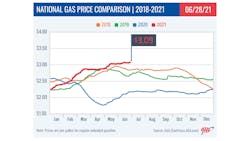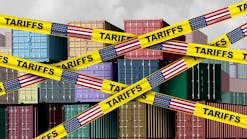At $3.09, the national gas price average is at its highest of the year and not stopping. That average will increase, possibly as much as another nickel, in the lead up to Independence Day as AAA forecasts a record-breaking 43.6 million Americans will hit the road for a holiday getaway.
This year’s Independence Day holiday weekend is defined as Thursday, July 1, through Monday, July 5.
While it is typical to see gas prices increase ahead of a holiday, AAA observed, especially during the peak summer driving season, pump price increases as of late have been noticeable.
“Today, 89% of U.S. gas stations are selling regular unleaded for $2.75 or more. That is a stark increase over last July 4 when only a quarter of stations were selling gas for more than $2.25,” said Jeanette McGee, AAA spokesperson.
Independence Day holiday period comparisons 2014-2021 »
- July 2-6, 2014: $3.66
- July 1-5, 2015: $2.76
- June 30-July 4, 2016: $2.27
- June 30-July 4, 2017: $2.23
- July 3-8, 2018: $2.86
- July 3-7, 2019: $2.75
- July 1-5, 2020: $2.17
- June 28, 2021: $3.09
Crude oil, and in turn gas prices, are more expensive compared with years past mostly due to three major factors: confidence in worldwide vaccination rollout, global oil demand spikes and the easing of travel restrictions leading to optimism for leisure travel.
Last week, crude oil sold at $74/bbl, the highest price in nearly three years. Route operators can expect little relief at the pump following the holiday. With crude oil prices likely to continue climbing, gas prices are most likely to see increases through the end of summer.
Today’s national average is more expensive on the week (+2¢), the month (+5¢) and the year (+92¢).
The latest weekly increase follows the latest data from the Energy Information Administration, which showed that gas demand increased from 9.36 million b/d to 9.44 million b/d, while total domestic gas stocks decreased by 3 million bbl to 240 million bbl.
AAA Quick Stats
The nation’s top 10 largest weekly increases: Utah (+12¢), Indiana (+11¢), Oregon (+9¢), Washington (+9¢), New Mexico (+8¢), Alaska (+8¢), Wyoming (+8¢), Idaho (+8¢), Minnesota (+7¢) and Colorado (+7¢).
The nation’s top 10 least expensive markets: Mississippi ($2.73), Louisiana ($2.74), Texas ($2.77), Arkansas ($2.79), Alabama ($2.80), Oklahoma ($2.80), Missouri ($2.80), South Carolina ($2.81), Tennessee ($2.84) and Kentucky ($2.85).
Oil Market Dynamics
At the close of Friday’s formal trading session, WTI increased 75¢ to settle at $74.05. Crude prices increased last week due to optimism that vaccine rollout will continue to help crude demand recover. In fact, the price of crude crossed the $74 per barrel threshold and prices have not been at this level since October 2018. Additionally, crude prices were bolstered by EIA’s latest report revealing that total domestic crude supplies decreased by 7.6 million bbl to 459.1 million bbl. For this week, another reduction in domestic crude supply could push prices up further after EIA’s next weekly report is released.





